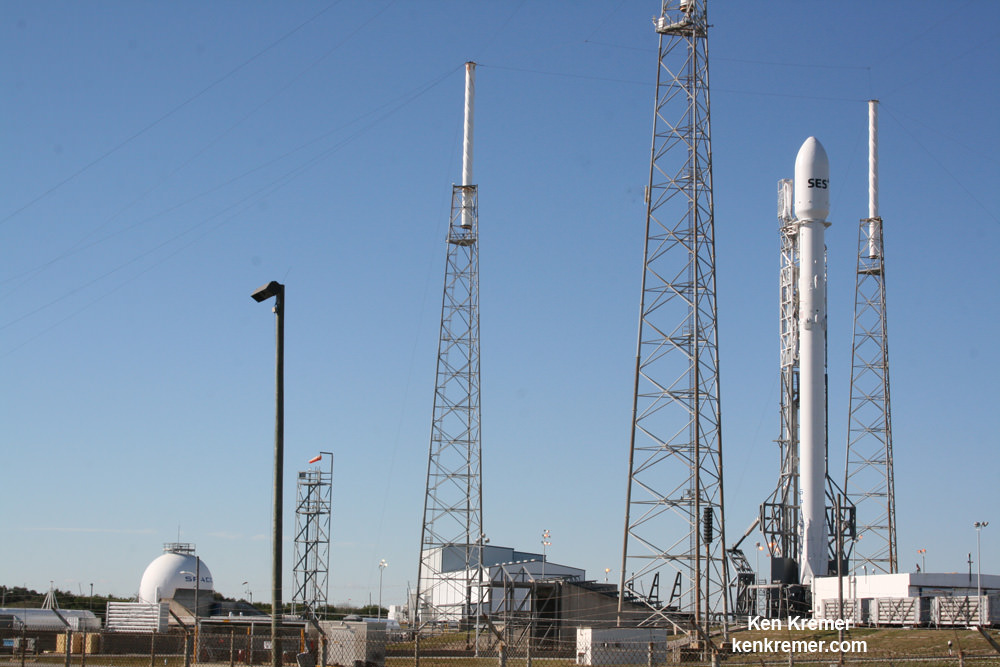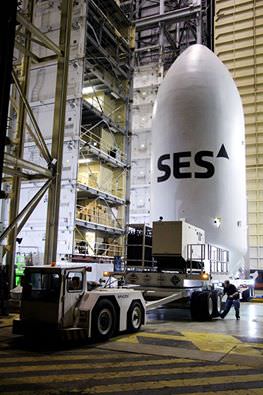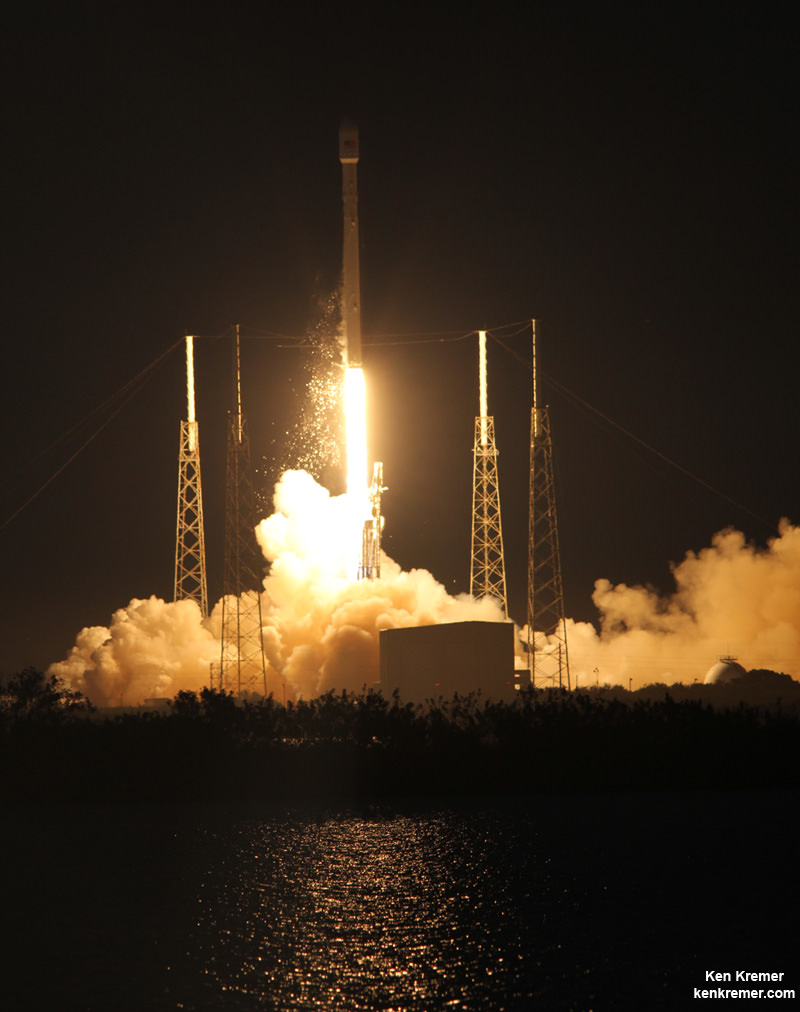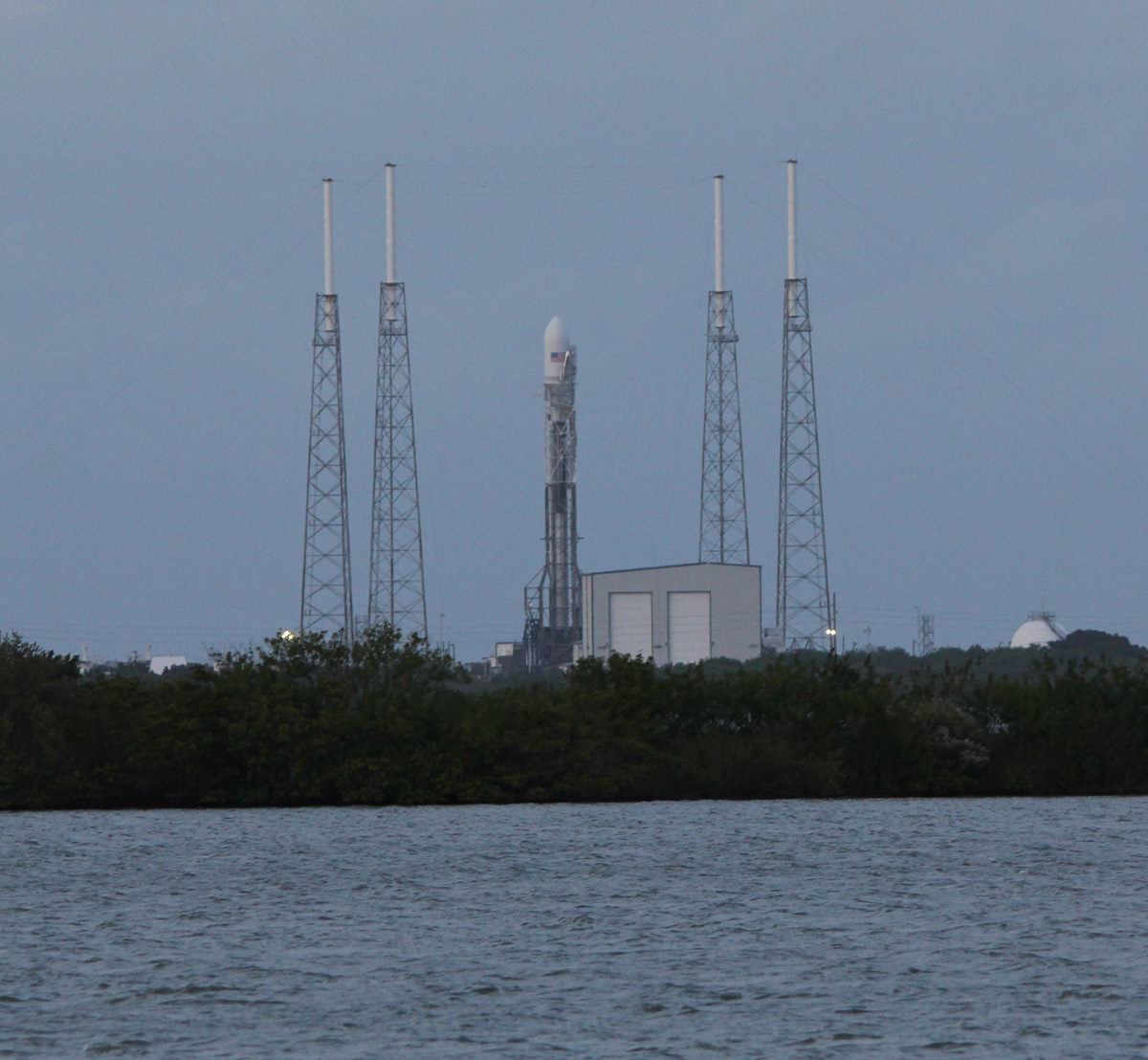
CAPE CANAVERAL AIR FORCE STATION, FL – Final preparations are underway for SpaceX’s first launch of a Falcon 9 rocket from Cape Canaveral during 2016 with the commercial SES-9 television and communications satellite on Wednesday evening Feb. 24, following a smooth static fire engine test on Monday. Update: Technical issue postponed launch to Feb 25 at 6:46 pm.
The 229 foot tall Falcon 9 is slated to lift off from SpaceX’s seaside Space Launch Complex 40 on Cape Canaveral Air Force Station, Fla. at 6:46 p.m. EST at the opening of a 97-minute launch window.
The launch window closes at approximately 8:23 p.m. EST.
The two stage Falcon 9 rocket will boost SES-9 to a Geostationary Transfer Orbit (GTO). The satellite will be deployed approximately 31 minutes after liftoff.
The commercial launch was contracted by the Luxembourg based SES, a world-leading satellite operator. SES provides satellite-enabled communications services to broadcasters, Internet service providers, mobile and fixed network operators, and business and governmental organizations worldwide using its fleet of more than 50 geostationary satellites.
The successful full-duration static fire test of the Falcon 9 first stage engines clears the path to Wednesday’s launch of the Falcon 9 in a recently enhanced configuration with upgraded Merlin engines.
Following a full countdown demonstration and fueling of the Falcon 9 rocket erect at the pad, all nine first stage Merlin engines were briefly ignited for several seconds.
This marks only the second flight of this more powerful version of the SpaceX Falcon.
A live webcast will be available at SpaceX.com/webcast beginning about 20 minutes before liftoff, at approximately 6:26 p.m. EST on Wednesday, Feb. 24.
If needed, SpaceX has a backup launch opportunity reserved on the Eastern range for Thursday, Feb. 25 at approximately the same time at 6:46 p.m. EST.

Air Force meteorologists are predicting a 60 percent chance of favorable weather conditions at launch time.
The main concerns are rain and winds.
The weather prognosis increases to 80 percent GO on Thursday.
SpaceX previously launched the SES-8 satellite for SES on Dec. 3, 2013.

The primary mission of the liftoff of the SpaceX Falcon 9 is to carry the SES-9 payload to orbit.
SES-9 is the largest satellite dedicated to serving the Asia-Pacific region for SES.
With its payload of 81 high-powered Ku-band transponder equivalents, SES-9 will be the 7th SES satellite providing unparalleled coverage to over 20 countries in the region, according to SES.
The Boeing built SES-9 satellite has a dry mass of 2,835 kg and a fueled mass of 5,271 kg. The huge satellite sports a wingspan of 48 meters with two solar wings. In addition each wing is outfitted with six additional solar panels on each wing.
It is designed to operate for 15 years. It will be co-located with the SES-7 satellite at the prime orbital location of 108.2 degrees East.
The secondary test objective of SpaceX is to land the Falcon 9 rockets first stage on an ocean going barge about 300 miles offshore in the Atlantic Ocean.
The droneship barge is named “Of Course I Still Love You.”
SpaceX opfficials say they are not optimistic of a successful barge landing.
“Given this mission’s unique GTO profile, a successful landing is not expected.”
Three prior attempts to land on a barge off both US coasts came very close with pinpoint approaches to the vessel in the Atlantic Ocean and the Pacific Ocean. But the rocket tipped over in the final moments and was destroyed.
Last December SpaceX did accomplish a dramatically successful propulsive soft landing on land for the first time in history at SpaceX’s Landing Zone 1 complex located a few miles south of launch pad 40 at Cape Canaveral.
Watch for Ken’s onsite launch reports direct from Cape Canaveral Air Force Station in Florida.

Stay tuned here for Ken’s continuing Earth and planetary science and human spaceflight news.
………….
Learn more about SpaceX Falcon 9 rocket, ULA Atlas rocket, Orbital ATK Cygnus, ISS, Boeing, Space Taxis, Mars rovers, Orion, SLS, Antares, NASA missions and more at Ken’s upcoming outreach events:
Feb 23 to 25: “SpaceX, ULA, SLS, Orion, Commercial crew, Curiosity explores Mars, Pluto and more,” Kennedy Space Center Quality Inn, Titusville, FL, evenings

“Launch update
The Falcon 9 remains healthy in advance of SpaceX and SES’s mission to deliver the SES-9 satellite to Geostationary Transfer Orbit. Out of an abundance of caution, the team opted to hold launch for today to ensure liquid oxygen temperatures are as cold as possible in an effort to maximize performance of the vehicle. SpaceX is now targeting tomorrow, Thursday Feb. 25, at 6:46pm ET for launch of SES-9.”